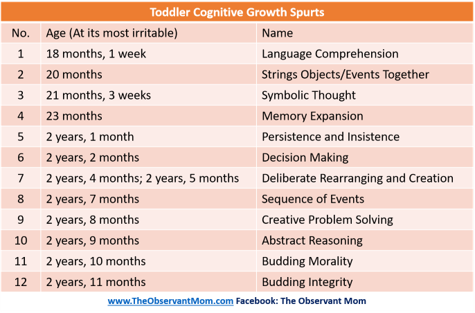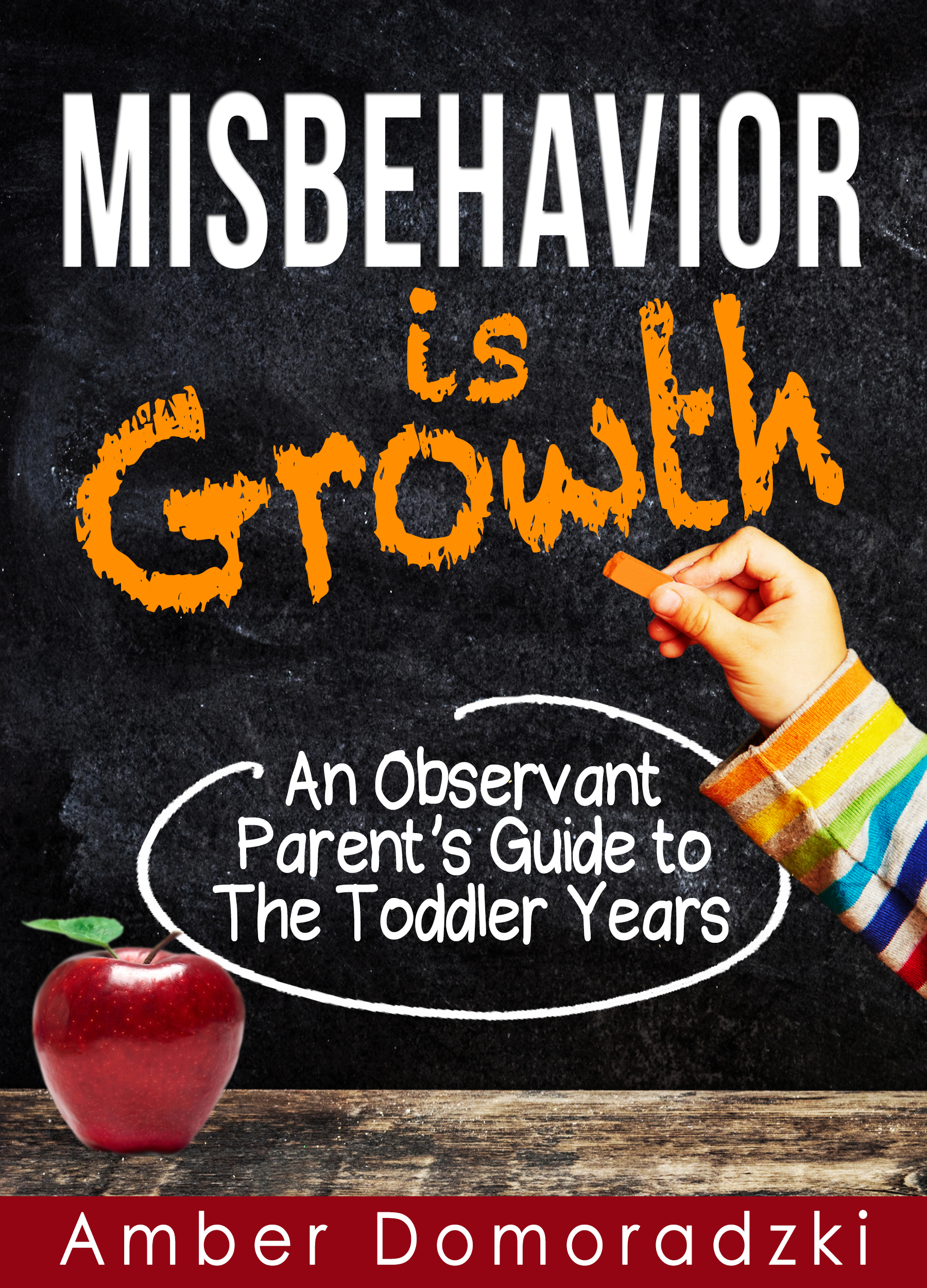This is a transcript to a short video I will produce showing how my work on cognitive growth spurts, the cycles of regression followed by a dramatic burst of ability that children go through, can help you develop your child’s language development in the toddler years. I outline my approach below that “misbehavior is growth”–the “misbehavior” seen at age-related times should be seen not as something to punish or ignore but as an opportunity to foster a development, which is the title of my book series on this. Let me know your feedback before I go into production.
Toddler Language Development the Misbehavior is Growth way: A Brief Introduction
Hi! I’m Amber. I’ve been doing research on the developmental cycles that children go through where they regress for a period of time but then have a dramatic burst of new ability. I wanted to make this video series to show how understanding these cycles can help with toddler language development. I’ll be making a video for each relevant age where a child goes through one of these developmental cycles, focusing on the ages between 18 months and 3 years, and I will show a few activities that you can do to develop their language skills. These activities will help build their vocabulary, help teach them to read, and improve reading comprehension. This first video is an introduction to the work I’ve been doing.
The best way I can explain my research is to show off some. This is a summary chart of the research I’ve been doing for the toddler years. You can find this chart on my website. TheObservantMom.com. There are three columns here. The first one simply lists the number of the milestone. In the toddler years, over the course of 18 months, there are 12 milestones. You might be doing the math in your head right now of just how frequent that is. The second column lists the age. I list here the age during the irritable period when things are at their worst, which is when I find parents start looking for information. And the third column lists the name of the milestone, which is based on the dominant new ability seen.

Each one of those milestones starts with a child who annoys you. Well, probably–it depends on your personal reaction to your child’s behavior. But the behaviors tend to be ones that irritate people and some would call “misbehavior.” During the toddler years, it is behaviors toddlers are already infamous for, such as:
- becoming possessive of their primary caregiver or all of their toys,
- having meltdowns over seemingly small things (but which are not small to them),
- whining,
- refusing to nap,
- tripping a lot,
…and what I see as a classic sign of cognitive growth, which is to look as if in seeming disbelief of what is around them. The reason for this behavior, especially a look of disbelief, is because there is something in their brain that is growing. The best way I’ve been able to explain it is to imagine the words “Under Construction” are written right on your child’s forehead. When their brain is “under construction,” everything goes a bit nuts for your child. They are growing and it’s scary at first. They notice things that they never noticed before, and at first it’s hard to process. But at the other side of this growth will be a child who is not only calm but has some new potential ability.
What I want to show with my research is that the craziness that children are known for has some order to it. And further to this, that there is a reason for it: they are growing. And because of this, one of the biggest messages I have is to see this crazy behavior not as something to punish or to ignore, but as an opportunity to help develop what is growing. This is the idea behind the title of my book series about this, “Misbehavior is Growth.” My book on toddlers is due out soon. This is the cover:

And so this is the main reason I am doing these videos. I want to show off this idea that misbehavior is growth. In each video, I will feature one relevant milestone. I’ll start off the video by listing the irritable behaviors you are likely seeing at that milestone. I’ll first of all encourage you to hang in there while dealing with these behavior, but then I’ll tell you that that’s your cue that something is growing and you can help develop it. So, it won’t be like any reading program you’ve ever heard of, because the first thing I am going to list are irritating behaviors. Then I will list one or a few activities that you can do with your child to help promote their language development.
I chose language to show off in this video series, but there are many more skills that can be developed at any given milestone, which I discuss further in my book. I chose language because I hope you see how this knowledge can really help you in a direct, practical way. The milestones are highly nuanced and the activities are very specific. The activities are likely things you already do, but I’ll provide just a little bit more clarity about when and how to do them to your great benefit. I hope that you’ll see the power of this paradigm where instead of fighting misbehavior, if you roll with it, you’ll see it can be to you and your child’s great benefit.
I look forward to the next video, which will be Milestone 1 at 18 months.
Come connect with me at Facebook as “The Observant Mom.” Come see my website, TheObservantMom.com, which as free printouts of my research, which is being used already by many parents. And come join the Facebook group I started as related to my book, which is “Misbehavior is Growth—The Discussion.”
Thanks for watching!
Your 18-month-old. Developing Their Language Skills the “Misbehavior is Growth” Way
Hello! This video is part of a series I am making about how understanding the developmental cycles of regression and progression that children go through, which I have been researching, can help develop their language development. This video is for Toddler Milestone 1 which starts at 18 months. (Show chart again.)
As promised, each of these videos starts off with the irritable behaviors you are likely seeing at the beginning of each milestone.
Toddler Milestone 1: Language Comprehension
Starts: 18 months
Most Intense: 18 months, 1 week
Ends: 19 Months
Irritable Period Summary
- Clingy
- Occasional Meltdowns
- Sleep schedule becomes erratic, e.g., unreliable nap times
Most intense period
- Very clingy with many meltdowns
If you’re dealing with this right now, mom and dad, hang in there, you’re doing a great job. Using the “Misbehavior is Growth” method, which is the title of my book series about this, the irritable behavior is your cue that something is growing. In this video I am going to present an activity you can do to help build their vocabulary.
This is the most important milestone when it comes to language development. I even named it “Language Comprehension.” There is a huge language explosion at this age. And I really should say there is a potential for a language explosion at this age. At this age, a child is likely to start saying many new words, about one per day, most of them are objects, and also the child understands many more words. If you’re not seeing this, there’s nothing wrong with your kid, don’t panic. I hope that this lesson, which is very easy, will help develop their vocabulary.
The lesson I am about to present is actually the lesson of all lessons when it comes to vocabulary and all you need is a picture book. I have here a simple book called “First 100 Animals.” However, there is an art to presenting pictures in order to increase vocabulary. I use the Three Stages of Learning as presented by Maria Montessori which is what I want to show you, and I’ll be using this cat to do it.
The first stage is identification. You point to the cat and say “cat.” This is all you do, and this is all you should do on the first day you give a lesson. Do as many objects as you want on this day, such as dog or pig, but do not ask any questions of the child on this first day. On the second day, after the child has slept, you can go to the Second Stage. The second stage is a multiple choice question. With the page open and several choices available, you ask the child, “which one is the cat?” They then have to point to the cat. I like to go back to stage one first before going to stage two. So I say, “cat,” and then immediately I ask, “which is the cat?” If they get it, you can keep going to Stage Three if you want. If they don’t get it, go back to Stage One. Stage Three is recall. This time you point to the cat and ask “what is this?” They then have to say “cat.” In doing this, they get practice with enunciation as well. If they don’t answer correctly at Stage Three, go back to either Stage Two or Stage One. I jump around in stages as I read with my child, responding to their answers. I do as many objects as they are interested in. You don’t have to do it with a picture book, you can also use real objects. I like picture books, because it offers many objects to practice with.
At this age, they also grow in their fine motor ability. Anything at all that encourages this is ideal, whether it is a puzzle or holding a pencil. In my next video, I present an activity where they do a letter puzzle so having practice with fine motor activities is ideal for that.
Thanks for watching!